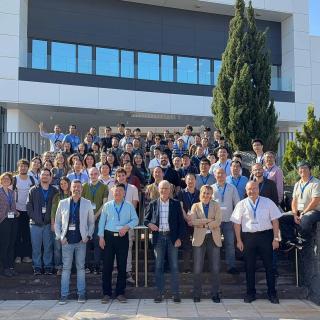Caption: Total solar eclipse from Novosibirsk (Russia). In a total eclipse of the Sun, the Moon exactly covers the disk of the Sun. For a few minutes there is almost total darkness (in broad daylight) and you can see the sun's corona, the stars and the brightest planets. Credits: J.C. Married & D. Lopez - starryearth.com. Shelios 2008.
An international team led by the University of Queen, of Belfast, and in which the researcher of the Institute of Astrophysics of the Canary Islands (IAC) Andrés Asensio Ramos participates, discovers why the magnetic waves inside the Sun strengthen and grow as They surface. An explanation of the high temperature of the solar corona, greater than that of the surface of the Sun despite being further from the source of heat, as the journal Nature Astronomy published today.
For more than 60 years, the observations of the Sun showed that magnetic waves grew in strength as they left the solar interior, but until now it was unknown why this happened. The high temperatures of the crown have also always been a mystery. Usually, the closer we are to a heat source, the warmer we feel. However, this is the opposite of what seems to happen in the Sun: its outer layers are warmer than the heat source on its surface.
Scientists have long accepted that magnetic waves channel energy from the vast interior energy deposit of the Sun, which is powered by nuclear fusion, to the outer regions of its atmosphere. Therefore, understanding how wave movement is generated and propagated throughout the star is of great importance to researchers.
The team, led by Queen's University and which includes 13 scientists from five countries and 11 research institutes, including the Canary Islands Institute of Astrophysics, form a consortium called "Waves in the lower solar atmosphere (WaLSA)" to carry out the investigation making observations in high resolution of the Dunn solar telescope, of the National Science Foundation, in New Mexico.
“This new understanding of the movement of the waves - explains David Jess, from the Faculty of Mathematics and Physics of Queen's University and principal investigator - can help us discover the missing piece in the puzzle of why the outer layers of the Sun are hotter than its surface, despite being farther from the heat source. By dividing the sunlight into its basic colors, we were able to examine the behavior of certain elements of the periodic table within its atmosphere, including silicon (formed near the surface of the Sun), calcium and helium (formed in the chromosphere where the amplification of the wave is most evident). ”
And he adds: “The variations in the elements allowed us to discover the plasma's velocities of the Sun. The time scales on which they evolved were compared, which allowed recording the frequencies of the Sun's waves. This is similar to how a complex musical ensemble it is deconstructed in basic notes and frequencies by displaying its musical score. ”
Later, the team has been able to make computer simulations using supercomputers. "As a result - reports Andrés Asensio Ramos - we have discovered that the wave amplification process can be attributed to the formation of an 'acoustic resonator', where significant changes in temperature between the surface of the Sun and its outer crown create limits that they are partially reflective and act to catch the waves, which allows them to intensify and grow dramatically in strength. ”
Researchers have also found that the thickness of the resonance cavity, the distance between significant changes in temperature, is one of the main factors that govern the characteristics of the detected wave movement. “This effect - says David Jess - is similar to how an acoustic guitar changes the sound it emits through the shape of its hollow body. If we think about this analogy, we can see how the waves captured in the Sun can grow and change as they leave their surface and move towards the outer and outer layers. "
The world Physics community is making plans to conduct more research using the latest generation solar telescopes that will be available in the coming years, such as the European Solar Telescope (EST), which will be installed in the Canary Islands.
Contact:
Andrés Asensio Ramos: andres.asensio [at] iac.es (andres[dot]asensio[at]iac[dot]es) +34922605417
Article: David B. Jess et al. "A chromospheric resonance cavity in a sunspot mapped with seismology." Nature Astronomy.
DOI: 10.1038 / s41550-019-0945-2.
https://www.nature.com/articles/s41550-019-0945-2



